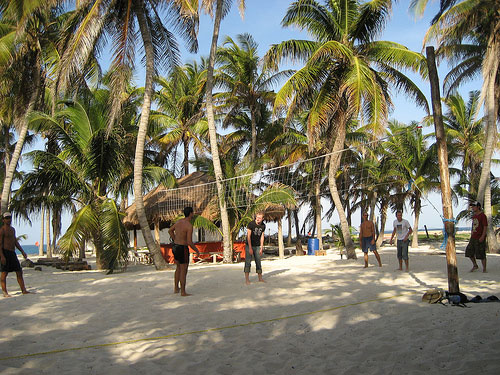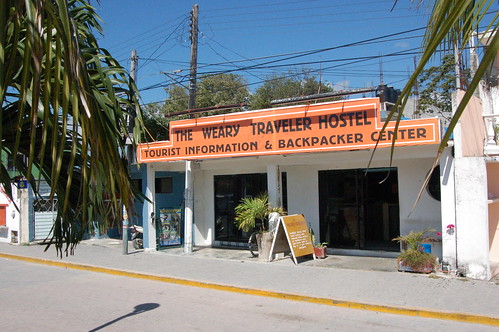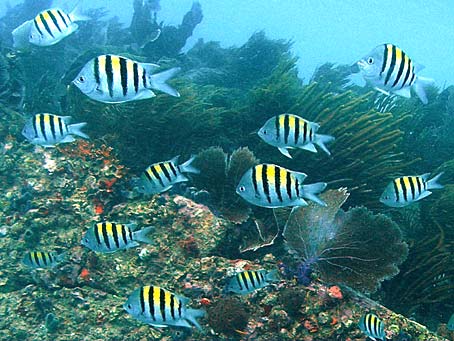Click on the photos for a larger view // Smellið á myndirnar til að sjá þær stærri
We got up at sunrise on Sunday morning, ready to take a ferry to Mexico. There was quite a strong wind blowing when we got to the pier and therefore the ocean was too rough for the small boat that was supposed to take us to San Pedro on nearby Ambergris Caye and our rendezvous with the luxury ferry to Chetumal, Mexico. We waited an hour until a larger boat arrived to take us the half an hour to San Pedro. In San Pedro we only stopped for a few minutes to change boats and to go through Belizean immigration. When you exit the country by boat you have to pay a departure tax of seven Belize dollars, which is a lot cheaper than the thirty seven Belize dollars you have to pay if you exit on land. So while the boat was a little more expensive than buses would have been, the whole trip ended up being cheaper, and much faster. The only problem was that the sea was pretty choppy on the way to Chetumal and the relatively small but comfortably equipped plastic boat was whizzing across the water at such speed that the front of the boat kept flying of the waves and slamming down again on the next one. The impact was sometimes so rough that we wondered if the boat might break in half at any second.
Við vöknuðum við sólarupprás á sunnudagsmorgni, tilbúin að taka ferju til Mexíkó. Það var ansi hvasst þegar við komum niður á bryggu og sjórinn var aðeins of úfinn fyrir litla bátinn sem átti að fara með okkur til San Pedro á Ambergris Caye þar sem við áttum stefnumót við lúxusferjuna til Chetumal í Mexíkó. Við biðum í klukkutíma þar til stærri bátur mætti á svæðið og skutlaði okkur hálftíma leið til San Pedro. Við stoppuðum bara í nokkrar mínútur í San Pedro til þess að skipta um bát og fara í gegnum vegabréfaskoðun í Belize. Þegar maður fer úr landi með bát þarf maður að borga sjö Belize dollara í brottfararskatt, sem er mikið ódýrara en þrjátíu og sjö dollararnir sem maður borgar ef maður fer yfir landamærin á þurru landi. Þannig að þótt báturinn væri örlítið dýrari en rútur hefðu verið, þá var ferðin öll ódýrari, og tók miklu styttri tíma. Eina vandamálið var að sjórinn var svolítið úfinn á leiðinni til Chetumal og þessi tiltölulega litli en þægilega útbúni bátur þaut yfir öldurnar á svo miklum hraða að framendinn lyftist af öldunum og skall svo niður á þeirri næstu. Höggið var stundum svo mikið að við veltum því fyrir okkur hvort báturinn gæti hreinlega brotnað hvað úr hverju.
 |
| The sunrise the day we left/ Sólarupprás daginn sem við fórum |
After passing through immigration on the pier in Chetumal, we shared a taxi with another American passenger to the bus terminal and caught a bus ten minutes later to Tulum. The buses in Mexico are much nicer than in the rest of Central America and even though we were on an economy bus we had nice, comfortable, reclining seats and curtains covering the windows so we slept most of the way to Tulum. When we did arrive we found the Weary Traveler hostel we planned on staying was just a couple of blocks away and we were soon checked in and relaxing in their big courtyard. At the Weary Traveler they have a good cheap way of selling good food. When you buy your breakfast or dinner you cook your eggs and meat yourself. They then have all sorts of side dishes and condiments available so you can get a great meal for very cheap. You can also bring in your own food to make your meals even more delicious. After our meal we walked a little along the main street in Tulum, a wide boulevard lined with hotels, restaurants and souvenir shops.
Eftir að hafa farið í gegnum vegabréfaskoðun á bryggjunni í Chetumal þá tókum við leigubíl með öðrum farþega frá Bandaríkjunum á rútustöðina og tókum rútu tíu mínútum seinna til Tulum. Rúturnar í Mexíkó eru töluvert huggulegri en annars staðar í Mið-Ameríku og þó svo við værum í tiltölulega ódýrri rútu þá voru sætin þægileg og hægt að halla þeim aftur og draga fyrir gluggana svo við sváfum mest alla leiðina til Tulum. Þegar við komum á áfangastað komumst við að því að Weary Traveler hostelið þar sem við ætluðum að gista var bara örstutt frá og við vorum fljót að koma okkur fyrir og farin að slappa af í rúmgóðum garðinum. Þeir á Weary Traveler eru með sniðuga og ódýra leið í matsölu. Þegar maður kaupir morgunmat eða kvöldmat þá þarf maður að elda eggin og kjötið sjálfur. Þeir bjóða síðan upp á alls konar meðlæti og álegg svo maður fær góða máltíð mjög ódýrt. Það má líka koma með sinn eigin mat svo máltíðirnar geta orðið enn girnilegri. Eftir kvöldmáltíðina þá röltum við eftir aðalgötunni í Tulum, breiðgötu með hótelum, veitingastöðum og minjagripabúðum við hvert fótmál.
The next day, after enjoying breakfast, we hopped on the free bus that the hostel offers to the beach. The beach in Tulum is the whitest one we have ever seen. We walked further along the coast and headed to the ruins that have made Tulum famous. The Tulum ruins are very different from others we have visited, mainly because of their location right by the seaside. Some buildings are perched on cliffs right above the small beach underneath that can not be accessed except through the ruins. So you can combine a cultural outing and a trip to the beach. We have now reached an area that has much more tourists than where we have been and the ruins bear witness to this. Instead of the feeling of discovery we got in Tikal, this felt more like browsing the museums and monuments of Washington, DC. Apart from the tropical beaches of course. And then there were the Iguanas everywhere, we've never seen those in a museum.
Daginn eftir, þegar við vorum búin að fá okkur ljúffengan morgunmat, stukkum við með ókeypis rútunni sem hostelið býður uppá niður á strönd. Ströndin í Tulum er sú hvítasta sem við höfum nokkurn tíma séð. Við löbbuðum aðeins lengra meðfram sjónum og tókum stefnuna á rústirnar sem Tulum er þekkt fyrir. Rústirnar í Tulum eru mjög ólíkar öðrum sem við höfum heimsótt, aðallega vegna staðsetningarinnar við sjóinn. Sumar byggingarnar standa alveg við klettabrúnina fyrir ofan litla strönd sem er ekki hægt að komast á nema í gegnum rústirnar. Svo það er hægt að sameina menningu og ferð á ströndina. Við erum núna komin á svæði þar sem er mun meira af túristum en þar sem við höfum verið og rústirnar bera þess merki. Í stað þess að líða eins og við séum að uppgötva eitthvað eins og í Tikal þá er þetta líkara því að skoða söfnin og minnismerkin í Washington, DC. Fyrir utan hitabeltisstrendurnar auðvitað. Og svo voru Iguana eðlurnar út um allt, við höfum aldrei séð þær á safni.





After our visit to the ruins we walked back to the beach and sunbathed for a little while. Later the wind picked up though and some clouds started to obscure the sun, so we ended up grabbing a taxi back to the hostel earlier than we had intended. During the evening we had another great meal and relaxed in hammocks in the courtyard. We were really starting to get the hang of the relaxing Caribbean way of life.
Eftir heimsóknina í rústirnar þá röltum við aftur niður á ströndina og lögðumst aðeins í sólbað. Seinna fór samt aðeins að hvessa og skýin fóru að slæðast fyrir sólina svo á endanum tókum við leigubíl aftur á hostelið örlítið fyrr en við höfðum ætlað. Um kvöldið fengum við okkur aðra ljúffenga máltíð og slökuðum á í hengirúmum í garðinum. Við erum að verða ansi sjóuð í þessum afslappaða karabíska lífsstíl.










































































